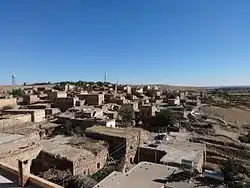Altıntaş, Midyat
Altıntaş (Syriac: ܟܦܪܙܗ, romanized: Kfarze,[2][nb 1] or Syriac: ܟܦܪܙܐ,[8] Kurdish: Kevirzê)[9] is a village in Mardin Province in southeastern Turkey. It is located in the district of Midyat and the historical region of Tur Abdin.
Altıntaş | |
|---|---|
 | |
 Altıntaş Location in Turkey | |
| Coordinates: 37.444°N 41.527°E | |
| Country | |
| Province | Mardin Province |
| District | Midyat |
| Population (2019)[1] | |
| • Total | 208 |
In the village, there are churches of Yoldath Aloho, Mor Yohannon, Mor Abrohom, and Mor Izozoel.[10] There is also the ruins of the churches of Mor Eliyo and Mor Malke.[11] The monastery of Mor Moses was located nearby the village, which was constructed by 1085.[12]
Etymology
The Turkish name of the village comprises two words, "altın" ("gold" in Turkish) and "taş" ("stone" in Turkish), therefore Altıntaş translates to "gold stone".[7] The Syriac name of the village is derived from "kfar" ("village" in Syriac).
History
It was attested that Emperor Anastasius I Dicorus (r. 491–518) had constructed a church at Kfarze, however, the historian Andrew Palmer argues this was fabricated to add historicity.[13] The church of Mor Izozoel at Kfarze was likely constructed in the late 7th century AD.[10] The village is first mentioned in 935 AD (AG 1246),[11] as attested by an inscription to commemorate the construction of the outdoor oratory (Syriac: Beth Slutho) at the church of Mor Izozoel.[14] The church of Mor Izozoel was looted by Kurds in 1416, and led to the loss of an icon of the church's patron saint.[15] The Kurdish rebel Izz al-Din Scher (Kurdish: Yezdanşêr), a relative of Emir Bedir Khan Beg of Bohtan, attacked Kfarze in 1855, which resulted in severe damage to the church of Mor Izozoel and the death of many of the village's inhabitants, including four priests.[16]
The British archaeologist Gertrude Bell visited the village in 1909 and 1911.[10] In 1914, Kfarze was inhabited by approximately 160 Syriac Orthodox Assyrian families and 70 Muslim families.[17] During the Assyrian Genocide, upon receiving news of an impending Kurdish attack, most of the village's Assyrian population fled to Inwardo whilst those who remained were killed.[18] The Assyrians later returned to Kfarze in 1922.[18] Part of the nave vault of the church of Mor Izozoel collapsed during the First World War or immediately after, and was restored in 1936.[7]
A significant number of the village's Assyrian population emigrated abroad to Germany, Belgium, and France in the late 20th century.[19] Kurds of Kfarze belong to the Dermemikan clan, and the village acts as the centre of the tribe.[20] The Kurdish poet Şivan Perwer is a notable descendant of the Muslim population of Kfarze.[20] In 2005, the village was populated by 12 Assyrian families and 35-40 Kurdish families,[21] and by 2013, Kfarze was inhabited by 11-12 Assyrian families and 23 Kurdish families.[19] The Assyrian population of Kfarze speak Turoyo.[11]
Notable people
- Saint Severus of Kfarze, abbot of Qartmin (fl. 410).[22]
- Dionysius David, Syriac Orthodox Archbishop of Qartmin and Beth Risha (r. 1220–1230).[23]
- Basil Behnam, Syriac Orthodox Maphrian of Tur Abdin (r. 1561–1562).[24]
- Yuhanna Awgen, Syriac Orthodox Archbishop of Qartmin (r. 1667–1707).[25]
- Julius Simon, Syriac Orthodox Archbishop of the Monastery of the Cross (r. 1833–1856).[26]
- Cyril Zaytun Sawar, Syriac Orthodox Archbishop of the Monastery of the Cross (r. 1842–1854).[27]
References
Notes
Citations
- "ALTINTAŞ MAHALLESİ NÜFUSU MİDYAT MARDİN". Türkiye Nüfusu (in Turkish). Retrieved 16 January 2021.
- Carlson, Thomas A. (9 December 2016). "Kfarze". The Syriac Gazetteer. Retrieved 16 January 2021.
- Barsoum (2008), p. 33.
- Barsoum (2003), p. 559.
- Biner (2019), p. x.
- "Bu köylerin isimleri değişecek!". Sözcü (in Turkish). 14 February 2015. Retrieved 27 December 2019.
- Sinclair (1989), p. 246.
- "Keferze". Keferze (in German). Retrieved 16 January 2021.
- Sediyani (2009), p. 255.
- Sinclair (1989), p. 248.
- "Geschichte von Keferze". Keferze (in German). Retrieved 16 January 2021.
- Palmer (1990), p. 195.
- Palmer (1990), p. 52.
- Palmer (1990), p. 211.
- Barsoum (2008), p. 68.
- Barsoum (2008), pp. 84–85.
- Gaunt, Bet̲-Şawoce & Donef (2006), p. 234.
- "Kfarze". Foundation for Conservation and Promotion of the Aramaic Cultural Heritage (in German). Retrieved 16 January 2021.
- Courtois (2013), p. 149.
- "Altıntaş". Index Anatolicus (in Turkish). Retrieved 16 January 2021.
- Csató, Isaksson & Jahani (2005), p. 182.
- Fiey (2004), p. 173.
- Barsoum (2008), pp. 33–34.
- Barsoum (2008), p. 46.
- Barsoum (2008), p. 50.
- Barsoum (2008), p. 39.
- Barsoum (2008), p. 51.
Bibliography
- Barsoum, Aphrem (2003). The Scattered Pearls: A History of Syriac Literature and Sciences. Translated by Matti Moosa (2nd ed.). Gorgias Press. Retrieved 14 July 2020.
- Barsoum, Aphrem (2008). The History of Tur Abdin. Translated by Matti Moosa. Gorgias Press.
- Biner, Zerrin Ozlem (2019). States of Dispossession: Violence and Precarious Coexistence in Southeast Turkey. University of Pennsylvania Press.
- Courtois, Sébastien de (2013). "Tur Abdin : Réflexions sur l'état présent descommunautés syriaques du Sud-Est de la Turquie,mémoire, exils, retours". Cahier du Gremmamo (in French). 21: 113–150.
- Csató, Éva Ágnes; Isaksson, Bo; Jahani, Carina (2005). Linguistic Convergence and Areal Diffusion: Case Studies from Iranian, Semitic and Turkic. Psychology Press. ISBN 9780415308045.
- Fiey, Jean Maurice (2004). Lawrence Conrad (ed.). Saints Syriaques (in French). The Darwin Press.
- Gaunt, David; Bet̲-Şawoce, Jan; Donef, Racho (2006). Massacres, Resistance, Protectors: Muslim-Christian Relations in Eastern Anatolia During World War I. Gorgias Press.
- Palmer, Andrew (1990). Monk and Mason on the Tigris Frontier: The Early History of Tur Abdin. Cambridge University Press. Retrieved 15 July 2020.
- Sediyani, İbrahim (2009). Adını arayan coğrafya (in Turkish). Özedönüş Yayınları. ISBN 9786054296002.
- Sinclair, T.A. (1989). Eastern Turkey: An Architectural & Archaeological Survey, Volume III. Pindar Press. ISBN 9780907132349.
| Wikimedia Commons has media related to Altıntaş, Midyat. |